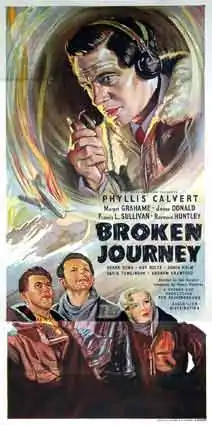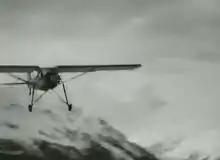Broken Journey
Broken Journey (also known as Rescue) is a 1948 British drama film directed by Ken Annakin and featuring Phyllis Calvert, James Donald, Margot Grahame, Raymond Huntley and Guy Rolfe.[2] Broken Journey deals with people struggling to survive after their airliner crashes on top of a mountain, and is based on a true-life accident in the Swiss Alps.[3]
| Broken Journey | |
|---|---|
 | |
| Directed by | Ken Annakin Michael C. Chorlton |
| Produced by | Sydney Box Roy Rich |
| Written by | Robert Westerby |
| Starring | Phyllis Calvert James Donald Margot Grahame Francis L. Sullivan |
| Music by | John Greenwood |
| Cinematography | Jack E. Cox |
| Edited by | Esmond Seal |
Production company | |
| Distributed by | General Film Distributors (1948) (UK) (theatrical) Eagle-Lion Films (1949) (USA) |
Release date |
|
Running time | 89 minutes |
| Country | United Kingdom |
| Language | English |
| Budget | £197,000[1] |
| Box office | £118,200 (December 1949)[1] |
Plot
In postwar Europe, while flying over the Swiss Alps, a Fox Airways Douglas DC-3 airliner experiences engine trouble and sends out a distress call. Pilot Captain Fox (Guy Rolfe) and co-pilot Bill Haverton (James Donald) set the aircraft down on a glacier with a minimum of damage, but know that they will not be able to radio for help with run-down batteries and a storm setting in.
Taking stock of their situation, Haverton knows he can rely on stewardess Mary Johnstone (Phyllis Calvert), who is in love with him, but some of the passengers present problems. Film star Joanna Dane (Margot Grahame), opera tenor Perami (Francis L. Sullivan) and iron lung patient John Barber (Grey Blake) are all, in different ways, difficult and demanding passengers. The wrecked aircraft provides them with shelter, as the 13 passengers and crew wait for rescue.
Rescue missions have already been mounted but, when a rescue aircraft misjudges its approach, it crashes and the crew are killed. With limited food supplies, the survivors realise that a rescue in the desolate location is unlikely. The survivors have to decide whether to stay and wait for help or leave the shelter of the wrecked airliner and set out in bad weather to try to reach safety. Some people make sacrifices to allow others to live.
Cast
- Phyllis Calvert as Mary Johnstone
- James Donald as Bill Haverton
- Margot Grahame as Joanna Dane
- Francis L. Sullivan as Perami
- Raymond Huntley as Edward Marshall
- Derek Bond as Richard Faber
- Guy Rolfe as Captain Fox
- David Tomlinson as Jimmy Marshall
- Sonia Holm as Anne Stephens
- Grey Blake as John Barber
- Sybille Binder as Lilli Romer
- Andrew Crawford as Kid Cormack
- Charles Victor as Harry Gunn
- Gerard Heinz as Joseph Romer
Production
Real Life Inspiration

The plot of Broken Journey closely approximated the 1946 C-53 Skytrooper crash on the Gauli Glacier, Switzerland in November 1946.[5] The improvised operation that eventually resulted in the successful rescue of eight passengers and four crew members, considered the "birth of air-rescue in Switzerland", garnered worldwide publicity and led to the fictionalised account of Broken Journey.[6]
Development
Sydney Box became head of production of Gainsborough Studios in 1946. He commissioned Robert Westerby, who had a reputation for writing contemporary thrillers, to do a script. Michael Balcon was also developing a film based on the same story, and registered an idea with the British Producers Association, but once he heard Box was doing a film as well he withdrew his project.[7]
Westerby did a treatment in six days, then proceeded to a full draft. He wrote a role specifically for Phyllis Calvert, then one of the studio's biggest stars. Calvert was reluctant to make the film but Box managed to persuade her.[7] It would be the last film Calvert made under her contract with Gainsborough.[8]
The film was originally called Rescue.[9]
Shooting
The film was shot over 14 weeks. Calvert was only available for half that time. There was location filming in Switzerland with studio work at Shepherd's Bush. Gainsborough had just finished making a film in the Alps called Snowbound (1947) so Annakin could draw on their expertise for the best locations.[7]
Principal photography for the film took place in 1947. At the same time, Annakin was completing work on his second feature film, Miranda (1948).[10] [N 1]
Reception
Box office
Broken Journey was a commercial disappointment recording a loss of £63,900.[1] This was attributed in part to the fact that the film came out 18 months after the accident which inspired it and was no longer topical.[7]
Critical
Broken Journey was critically received as a disaster film. Reviewer A.W. Weiler of The New York Times observed that the film was effective; "... (an) intelligent script and a uniformly excellent cast serve to make the import a diverting entertainment. And, the rugged, spectacular mountain backgrounds are an added note of authenticity to the yarn which accents character study rather than melodramatics." The reviewer, however, had a caution that "..'Broken Journey', which might have been a top-flight, thoroughly exciting excursion, is simply a meticulously-planned trip in which the travelers are more interesting than the itinerary."[12]
Steven H. Scheuer in Movies on TV, 1986–87 noted that the film was "tense, well acted melodrama."[13]
References
Notes
- Shortly after making his feature film debut as a director in Holiday Camp (1947), Annakin worked on Miranda (1948), released eight days before Broken Journey.[11]
Citations
- Spicer 2006, p. 210.
- "Review: 'Broken Journey'... The Australian Women's Weekly, Volume 16, Issue 21, 30 October 1948, p. 26. via National Library of Australia.
- "Sydney Box well ahead of target." The News, Volume 50, Issue 7, 29 May 1948, p. 7. via National Library of Australia.
- "Some History." Archived 20 August 2011 at the Wayback Machine gletscherflug.ch. Retrieved: 17 August 2014.
- Crandell, Hy. "150 88th Div. Men Enter Switz. As Rescue Party: All Passengers Survive Plane Crash; Swiss Troops Effect Rescue." Military History Network (milhist.net), 29 April 2004 (Originally published in The Blue Devil, Vol. 2, No. 24; 28 November 1946, pp. 1,6). Retrieved: 17 August 2014.
- "1946: The beginnings of air-rescue, 1946-1959." Archived 23 August 2014 at the Wayback Machine Rega. Retrieved: 18 August 2014.
- Spicer, Andrew. "The Apple of Mr. Rank’s mercatorial eye": Managing Director of Gainsborough Pictures, pp. 108-111.
- "Unnecessary agony in plane crash film." The Mail, Volume 36, Issue 1,873, 24 April 1948, p. 3. via National Library of Australia.
- RANDOM NOTES ABOUT PEOPLE AND PICTURES: Tracking Down an Author -- Bracken to Do Baseball Comedy -- Kiss for Autry By A.H. WEILER. New York Times 6 Apr 1947: X5.
- "Annakin, Ken (1914-2009)." BFI Screenonline. Retrieved: 17 August 2014.
- Baxter, Brian. "Ken Annakin Obituary." The Guardian, 25 April 2009.
- Weiler, A.W. "Rewview: 'Broken Journey' (1948); At the Trans-Lux." The New York Times, 26 May 1949.
- Scheuer 1986, p. 86.
External links
- Broken Journey at IMDb
- Review of film at Variety
- Broken Journey at AllMovie
- Broken Journey at the British Film Institute's Film and TV Database
